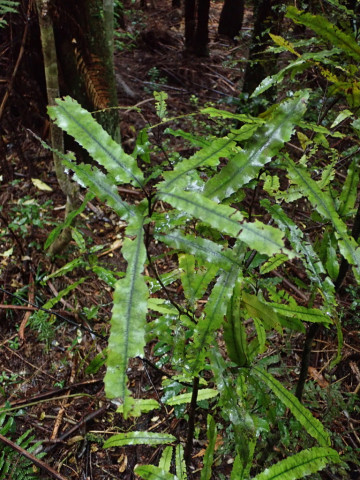The completion of the native rewarewa (Knightia excelsa) tree genome sequence is demonstrating New Zealand is now taking charge of producing genomes on its native species.
These are species that are important to us, and have taonga significance.

Rewarewa. Illustration credit: “Seven Sisters, Knightia excelsa” Jennifer Duval-Smith
The completion of the genome sequencing of the rewarewa by our team of Manaaki Whenua - Landcare Research, Plant & Food Research and University of Otago scientists is a really good example of the sequence now being available to use for the benefit of New Zealand.
The Genomics Aotearoa-funded research, led by Genomics Aotearoa postdoctoral researcher Ann McCartney, has developed a great set of techniques benchmarking genomic solutions which is precious and useful for the New Zealand genomics research community and internationally.
Fundamentally, doing this research using a high quality genome like the one we produced for rewarewa means we can gain a deeper understanding of which genes contribute to adaptation of this species to a range of climatic conditions.
We are now using the rewarewa genome to better understand the biology and diversity of this tree species to continue the growth of the Aotearoa New Zealand honey industry.
As well as commercial importance to our honey producers, establishing a high-quality genome for this taonga species has specific cultural importance to Māori. This tree had multiple traditional uses for Māori including medicinal, spiritual and for construction.
About the Rewarewa
Rewarewa, also known as the New Zealand honeysuckle, is unique in New Zealand. Endemic to Aotearoa New Zealand, it is mostly found on the North Island and the top of the South Island, and common in coastal, lowland and lower montane habitats.
Bees are also attracted to rewarewa, and produce a delicious honey which is described as “dark, malty and complex with a sweet finish.”
This tree had multiple traditional uses for Māori including medicinal, spiritual and for construction. Not only did Māori collect and eat the nectar of the rewarewa, they also picked the flowers in late spring and tapped them inside a gourd vessel, using the inner bark to bandage over a wound to stop bleeding and speed its healing. The wood was used for river posts and palisade walls.
Māori tradition suggests the distinctive, curved shape of the seed pods inspired the shape of the waka.
European settlers liked the reddish flecked wood and used it for decorative purposes in inlay and marquetry work, as well as in bush tramways, brake blocks, and fence battens. However, rewarewa was useless as firewood – being known as the ‘Bucket of Water’ tree.
About the research
Developing a high quality genome is challenging.

Rewarewa foliage. Photo credit: Alex Fergus.
Leaf samples were collected from a tree located in Northland, working with the Te Rarawa Anga Mua and the Komiti Kaitiaki for Warawara Ngahere.
DNA extraction was then carried out by Elena Hilario (Plant & Food Research), who indicated it was the most challenging species she has dealt with for extracting high quality DNA. Elena’s wet lab methods are available to the Genomics Aotearoa community and her skills are used for birds, insects, plants, algae and microbes.
This research enabled Genomics Aotearoa postdoctoral researcher Dr Ann McCartney and the High Quality Genome project team to investigate genome assembly strategies using rewarewa as a model.
Multiple data types were obtained; Illumina paired-end reads, Oxford Nanopore Technologies long reads and chromatin conformation capture Hi-C data. Software for contig assembly, polishing and error correction and Hi-C scaffolding were evaluated and quality metrics measured at each step.
These tools were systematically implemented and the accuracy of each assembly was quantitatively assessed in order to identify the optimal rewarewa genome assembly that could be generated from our data.
Ann’s work is very impressive. She generated no less than 160 genome assemblies, using many software and parameters to obtain the best rewarewa genome as possible. But most importantly her experience in doing so is very useful for all the other project members.
Our work was made possible by Genomics Aotearoa’s access to vital high performance computing facilities at NeSI.
Find out more about High Quality Genomes and Population Genomics here.